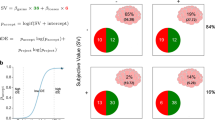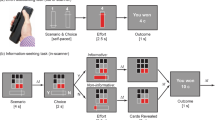Abstract
A key process in decision-making is estimating the value of possible outcomes. Growing evidence suggests that different types of values are automatically encoded in the ventromedial prefrontal cortex (VMPFC). Here we extend this idea by suggesting that any overt judgment is accompanied by a second-order valuation (a confidence estimate), which is also automatically incorporated in VMPFC activity. In accordance with the predictions of our normative model of rating tasks, two behavioral experiments showed that confidence levels were quadratically related to first-order judgments (age, value or probability ratings). The analysis of three functional magnetic resonance imaging data sets using similar rating tasks confirmed that the quadratic extension of first-order ratings (our proxy for confidence) was encoded in VMPFC activity, even if no confidence judgment was required of the participants. Such an automatic aggregation of value and confidence in a same brain region might provide insight into many distortions of judgment and choice.
This is a preview of subscription content, access via your institution
Access options
Subscribe to this journal
Receive 12 print issues and online access
$209.00 per year
only $17.42 per issue
Buy this article
- Purchase on Springer Link
- Instant access to full article PDF
Prices may be subject to local taxes which are calculated during checkout






Similar content being viewed by others
References
Von Neumann, J. & Morgenstern, O. Game Theory and Economic Behavior (Princeton Univ. Press, 1944).
Samuelson, P.A. A note on the pure theory of consumer's behaviour. Economica 5, 61–71 (1938).
Peters, J. & Buchel, C. Neural representations of subjective reward value. Behav. Brain Res. 213, 135–141 (2010).
Bartra, O., McGuire, J.T. & Kable, J.W. The valuation system: a coordinate-based meta-analysis of BOLD fMRI experiments examining neural correlates of subjective value. Neuroimage 76, 412–427 (2013).
Clithero, J.A. & Rangel, A. Informatic parcellation of the network involved in the computation of subjective value. Soc. Cogn. Affect. Neurosci. 9, 1289–1302 (2014).
Blood, A.J., Zatorre, R., Bermudez, P. & Evans, A. Emotional responses to pleasant and unpleasant music correlate with activity in paralimbic brain regions. Nat. Neurosci. 2, 382–387 (1999).
Chib, V.S., Rangel, A., Shimojo, S. & O'Doherty, J.P. Evidence for a common representation of decision values for dissimilar goods in human ventromedial prefrontal cortex. J. Neurosci. 29, 12315–12320 (2009).
Hare, T.A., Camerer, C.F., Knoepfle, D.T., O'Doherty, J.P. & Rangel, A. Value computations in ventral medial prefrontal cortex during charitable decision making incorporate input from regions involved in social cognition. J. Neurosci. 30, 583–590 (2010).
Lebreton, M., Jorge, S., Michel, V., Thirion, B. & Pessiglione, M. An automatic valuation system in the human brain: evidence from functional neuroimaging. Neuron 64, 431–439 (2009).
Plassmann, H., O'Doherty, J. & Rangel, A. Orbitofrontal cortex encodes willingness to pay in everyday economic transactions. J. Neurosci. 27, 9984–9988 (2007).
Levy, I., Lazzaro, S., Rutledge, R. & Glimcher, P. Choice from non-choice: predicting consumer preferences from blood oxygenation level-dependent signals obtained during passive viewing. J. Neurosci. 31, 118–125 (2011).
Harvey, A.H., Kirk, U., Denfield, G. & Montague, P. Monetary favors and their influence on neural responses and revealed preference. J. Neurosci. 30, 9597–9602 (2010).
Abitbol, R. et al. Neural mechanisms underlying contextual dependency of subjective values: converging evidence from monkeys and humans. J. Neurosci. 35, 2308–2320 (2015).
Kepecs, A., Uchida, N., Zariwala, H. & Mainen, Z. Neural correlates, computation and behavioural impact of decision confidence. Nature 455, 227–231 (2008).
De Martino, B., Fleming, S.M., Garrett, N. & Dolan, R.J. Confidence in value-based choice. Nat. Neurosci. 16, 105–110 (2013).
Rolls, E.T., Grabenhorst, F. & Deco, G. Choice, difficulty, and confidence in the brain. Neuroimage 53, 694–706 (2010).
Pleskac, T.J. & Busemeyer, J.R. Two-stage dynamic signal detection: a theory of choice, decision time, and confidence. Psychol. Rev. 117, 864–901 (2010).
Yu, S., Pleskac, T.J. & Zeigenfuse, M.D. Dynamics of postdecisional processing of confidence. J. Exp. Psychol. Gen. 144, 489–510 (2015).
Griffin, D. & Tversky, A. The weighing of evidence and the determinants of confidence. Cognit. Psychol. 24, 411–435 (1992).
Lichtenstein, S., Fischhoff, B. & Phillips, L.D. in Heuristics and Biases 306–334 (Cambridge Univ. Press, 1982).
Lebreton, M., Kawa, S., Forgeot d'Arc, B., Daunizeau, J. & Pessiglione, M. Your goal is mine: unraveling mimetic desires in the human brain. J. Neurosci. 32, 7146–7157 (2012).
Sharot, T., Riccardi, A.M., Raio, C.M. & Phelps, E.A. Neural mechanisms mediating optimism bias. Nature 450, 102–105 (2007).
Pierce, C.S. & Jastrow, J. On small differences of sensation. Mem. Natl. Acad. Sci. 3, 73–83 (1884).
Adams, J.K. A confidence scale defined in terms of expected percentages. Am. J. Psychol. 70, 432–436 (1957).
Vickers, D. Decision Processes in Visual Perception (Academic, New York, 1979).
Fleming, S.M. & Dolan, R.J. The neural basis of metacognitive ability. Phil. Trans. R. Soc. Lond. B 367, 1338–1349 (2012).
Yeung, N. & Summerfield, C. Metacognition in human decision-making: confidence and error monitoring. Phil. Trans. R. Soc. Lond. B 367, 1310–1321 (2012).
Daunizeau, J. A note on race models http://sites.google.com/site/jeandaunizeauswebsite/links/resources (2015).
Litt, A., Plassmann, H., Shiv, B. & Rangel, A. Dissociating valuation and saliency signals during decision-making. Cereb. Cortex 21, 95–102 (2011).
Maunsell, J.H. Neuronal representations of cognitive state: reward or attention? Trends Cogn. Sci. 8, 261–265 (2004).
Roesch, M.R. & Olson, C.R. Neuronal activity related to anticipated reward in frontal cortex: does it represent value or reflect motivation? Ann. NY Acad. Sci. 1121, 431–446 (2007).
Chua, E.F., Schacter, D.L., Rand-Giovannetti, E. & Sperling, R.A. Understanding metamemory: neural correlates of the cognitive process and subjective level of confidence in recognition memory. Neuroimage 29, 1150–1160 (2006).
Moritz, S., Glascher, J., Sommer, T., Buchel, C. & Braus, D.F. Neural correlates of memory confidence. Neuroimage 33, 1188–1193 (2006).
Schwarze, U., Bingel, U., Badre, D. & Sommer, T. Ventral striatal activity correlates with memory confidence for old- and new-responses in a difficult recognition test. PLoS ONE 8, e54324 (2013).
White, T.P., Engen, N.H., Sørensen, S., Overgaard, M. & Shergill, S.S. Uncertainty and confidence from the triple-network perspective: voxel-based meta-analyses. Brain Cogn. 85, 191–200 (2014).
Costa, V.D., Lang, P.J., Sabatinelli, D., Versace, F. & Bradley, M.M. Emotional imagery: assessing pleasure and arousal in the brain's reward circuitry. Hum. Brain Mapp. 31, 1446–1457 (2010).
Elliott, R., Newman, J.L., Longe, O.A. & Deakin, J.F.W. Differential response patterns in the striatum and orbitofrontal cortex to financial reward in humans: a parametric functional magnetic resonance imaging study. J. Neurosci. 23, 303–307 (2003).
Cooper, J.C. & Knutson, B. Valence and salience contribute to nucleus accumbens activation. Neuroimage 39, 538–547 (2008).
Levy, D. & Glimcher, P.W. The root of all value: a neural common currency for choice. Curr. Opin. Neurosci. 22, 1027–1038 (2012).
de Gardelle, V. & Mamassian, P. Does confidence use a common currency across two visual tasks? Psychol. Sci. 25, 1286–1288 (2014).
Daunizeau, J. On the exponential, sigmoid and softmax mappings http://sites.google.com/site/jeandaunizeauswebsite/links/resources (2014).
Deichmann, R., Gottfried, J., Hutton, C. & Turner, R. Optimized EPI for fMRI studies of the orbitofrontal cortex. Neuroimage 19, 430–441 (2003).
Friston, K.J., Penny, W.D. & Glaser, D.E. Conjunction revisited. Neuroimage 25, 661–667 (2005).
Acknowledgements
The study was funded by a Starting Grant for the European Research Council (ERC-BioMotiv) and a Research Grant from the Schlumberger Foundation. M.L. received a PhD fellowship from the French Ministère de la Recherche and an Amsterdam Brain and Cognition Talent Grant from the University of Amsterdam. R.A. received a PhD fellowship from the Direction Générale de l'Armement and a grant from the Fondation pour la Recherche Médicale. This work also benefited from the program “Investissements d'avenir” (ANR-10-IAIHU-06). The funders had no role in study design, data collection and analysis, decision to publish or preparation of the manuscript.
Author information
Authors and Affiliations
Contributions
M.L. and M.P. designed all experiments. M.L. and R.A. collected the data. M.L. performed the data analysis. J.D. formalized the computational model. M.L. and M.P. wrote the manuscript. All authors discussed the results and commented the manuscript.
Corresponding author
Ethics declarations
Competing interests
The authors declare no competing financial interests.
Supplementary information
Supplementary Text and Figures
Supplementary Table 1 (PDF 35 kb)
Supplementary Checklist
(PDF 232 kb)
Rights and permissions
About this article
Cite this article
Lebreton, M., Abitbol, R., Daunizeau, J. et al. Automatic integration of confidence in the brain valuation signal. Nat Neurosci 18, 1159–1167 (2015). https://doi.org/10.1038/nn.4064
Received:
Accepted:
Published:
Issue Date:
DOI: https://doi.org/10.1038/nn.4064
This article is cited by
-
A tripartite view of the posterior cingulate cortex
Nature Reviews Neuroscience (2023)
-
Attractor dynamics reflect decision confidence in macaque prefrontal cortex
Nature Neuroscience (2023)
-
Studying the neural representations of uncertainty
Nature Neuroscience (2023)
-
Neural and computational underpinnings of biased confidence in human reinforcement learning
Nature Communications (2023)
-
Mood fluctuations shift cost–benefit tradeoffs in economic decisions
Scientific Reports (2023)



